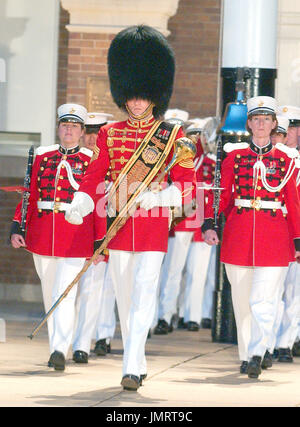

(Here, in some performances, Sousa's patriotic lyrics may be sung in a choral overlay.) Then follows the breakstrain, the final strain, and the breakstrain repeated. Now follows the dominant woodwinds in the first run of the famous Trio strain-familiar to many for the nonsense lyrics: "Be kind to your web-footed friends."-which repeats, and later repeats again as the piccolos obligato. Performances vary according to the arrangements of individual band directors or orchestrators, especially regarding tempo and the number and sequence of strains employed.Ī typical performance of the march begins with the four-bar introduction, following with the first strain, which is repeated then the second strain, which is also repeated and sometimes both are repeated again if (the band is) marching in parade (or the breakstrain may be interjected and repeated). military march form-of repeated phrasing of different melodies performed in sections called strains: a Sousa legacy. "The Stars and Stripes Forever" follows the standard U.S. Problems playing this file? See media help.

Arranged by American concert pianist Giorgi Latso, performed by The Latsos Piano Duo The Stars and Stripes Forever for 1 Piano, 4 Hands. At least 168 people were killed, though some estimates are much higher. One memorable example of its use was during the Hartford circus fire of July 6, 1944. Except for impending disaster, circus bands never played the tune under any circumstances. It subtly notified personnel of emergency situations and ideally allowed them to organize the audience's exit without causing the chaos and panic that an overt declaration might.
#U s marine band stars and strips forever code#
Historically, in show business and particularly in theater and the circus, this piece is called "the Disaster March." In the early 20th century, when it was common for theaters and circuses to have house bands, this march was a traditional code signaling a life-threatening emergency.

Following an Act of Congress in 1987, it was officially adopted as the national march of the United States of America. It was first performed at Willow Grove Park, just outside Philadelphia, on May 14, 1897, and was immediately greeted with enthusiasm. He composed the march in his head and committed the notes to paper on arrival in the United States. He was on board an ocean liner on his way home from a vacation with his wife in Europe and had just learned of the recent death of David Blakely, the manager of the Sousa Band. The instrument the sousaphone was named after this famous composer and bandleader.In his 1928 autobiography, Marching Along, Sousa wrote that he composed the march on Christmas Day, 1896.
#U s marine band stars and strips forever movie#
Actor Clifton Webb portrayed Sousa in the movie about his life entitled Stars and Stripes Forever. In addition to writing music, Sousa also wrote books, including the best-seller Fifth String and his autobiography, Marching Along. Field Artillery March," "Semper Fidelis" (written in 1888, it became the Marine Corps anthem), "Washington Post March" (1889), "King Cotton" (1895), "El Capitan" (1896), and many more. His most famous marches include "The Stars and Stripes Forever" (1897), "U.S. Sousa's Band also recorded many sides for the Victor label up through the early '30s. and European tours, a world tour, and an appearance in the 1915 Broadway show Hip-Hip-Hooray.

Sousa formed his sternly organized marching band in 1892, leading them through numerous U.S. Although most famous for his marches, Sousa composed in other styles as well, including a waltz, "Moonlight on the Potomac" a gallop, "The Cuckoo" (both in 1869) the oratorio "Messiah of the Nations" (1914) and scores for Broadway musicals The Smugglers (1879), Desiree (1884), The Glass Blowers (1893), El Capitan (1896 which was his first real scoring success), American Maid (1913), and more. Benkert, then worked as a pit orchestra conductor at a local theater, followed by jobs as first chair violinist at the Ford Opera House, the Philadelphia Chestnut Street Theater, and later led the U.S. While active in the Marines, he composed his first march, "Salutation." Around the age of 16, Sousa began studying harmony with G.F. Before this, Sousa had studied violin with John Esputa. Marine Corps, and enlisted by the age of 14. Born in Washington, D.C., on November 6, 1854, Sousa followed in the footsteps of his father, a musician in the U.S. John Philip Sousa wrote the most famous American military marches of all time, including "Stars and Stripes Forever," earning him the nickname "the March King" he was also known as a great bandleader, and organized the famed concert and military group, Sousa's Band.


 0 kommentar(er)
0 kommentar(er)
